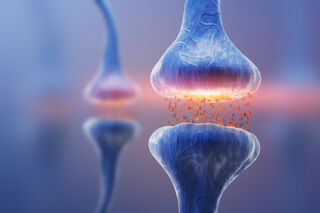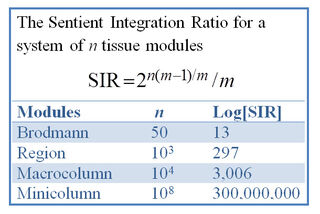Neuroscience
Consciousness and Integrated Information Theory
A more realistic and unambiguous measure of integrated consciousness is needed.
Posted December 13, 2021 Reviewed by Tyler Woods
Key points
- As currently formulated, integrated information theory (IIT) is not well-defined and is not a plausible "theory of consciousness."
- ITT does, however, properly emphasize the apparent critical importance of brain integration processes to a healthy consciousness.
- A crude model of brain integration contrasting neocortex with cerebellum is the Sentient Integration Ratio, but SIR is not a "theory."
- Estimates of brain integration have implications for end-of-life care, neuropsychiatric ailments, and developmental problems in children.
Integrated Information Theory (IIT) is a widely discussed—and, by some, strongly promoted —“mathematical theory of consciousness” developed over the past 10-20 years or so, mainly by neuroscientist Giulio Tononi. The theory proposes a single quantitative measure, called Φ (phi), which represents the amount of “integrated information” in brains and other systems, from single-celled organisms perhaps even to entire ecosystems. If a system consists of many modules, the “integrated information” of the entire system is distinct from the “local” information that is just the sum of information locked in all its modules. Such systems are conjectured to be meaningfully conscious if and only if they possess a sufficiently large Φ. The larger the integrated information value a system has, the more conscious it is considered to be.

A number of scientists have strongly criticized the promotion of IIT as a genuine “theory of consciousness,” while still supporting its substantial scientific contributions. In this regard, I have recently benefited from exchanges with computer scientist Scott Aaronson, whose blog post on integrated information theory has attracted some major players in the field: David Chalmers, Christof Koch, Giulio Tononi, Adam Barrett, and others. But, even a cursory evaluation of IIT raises several questions:
- According to the theory, incredibly simple systems (far simpler than single living cells) are claimed to possess some minimal level of consciousness. It seems plausible that simple animals may possess a non-zero level of consciousness. But what about other living systems like forests or even man-made systems, like airplanes, which are predicted by IIT to enjoy minimal consciousness levels?
- Can any single measure realistically quantify consciousness? Many might guess that, at best, Φ could provide one of several necessary conditions for consciousness to occur, but nothing even close to finding the sufficient conditions. The sufficiency question may have no answer accessible to our puny brains.
- The definition of “information” is ambiguous in IIT, partly because the general definition of information is not universal; it is context-dependent. For one thing, information is defined differently at different scales of description. In an extreme example, one may define the information in a brain or baseball as the positions and velocities of all of the elementary particles of each. Looking at it this way the baseball can be said to contain about the same information content (entropy) as a brain just because they have nearly the same mass. However, conscious baseballs seem to be unlikely creatures.
IIT rests on many foundational studies of how different parts of the brain interact with each other. My colleague and former graduate student Ramesh Srinivasan worked with Tononi, Gerald Edelman, and others at The Neural Sciences Institute in La Jolla and contributed to this work. In A Universe of Consciousness, (2000) Edelman and Tononi addressed the brain integration issue:
…high values of complexity correspond to an optimal synthesis of functional specialization and functional integration within a system. This is clearly the case for systems like the brain—different areas and different neurons do different things (they are differentiated) at the same time they interact to give rise to a unified conscious scene and to unify behaviors (they are integrated).
This statement points to the contrast between brain information that is localized to one area, and integrated information spread across many areas. Does the brain behave more like an integrated system, with robust communication between its parts? Or, does it behave more like a local system, with many little sub-systems that act more or less independently? To illustrate the difference, think of a football stadium packed with fans. Before the game begins, most exchanges of information occur between people sitting close together; the individual conversations are largely unrelated, perhaps one person talking to a friend about the quarterback’s passing stats. We’ll call this condition a “football fan state of functional localization.” The game begins, and a touchdown is scored. All of a sudden, the home team’s fans are cheering together en masse. The information of the touchdown is not spread slowly from one fan to another, but is integrated immediately to everyone. As a result, a new large-scale entity is created in the stadium that can then act top-down on each individual fan.

Integration in a Toy Brain
Returning to the issue of the ambiguous use of information in IIT, is there still a way to identify a useful measure of integration? Consider a toy brain that retains many of the basic structural features of a real brain. The toy consists of a cerebellum inter-connected only to its nearby tissue and a neocortex that also contains such local connections. But in contrast to the cerebellum, the neocortex (grey matter) is also interconnected by an enormous number (1010 ) of cortico-cortical axons forming the sub-cortical white matter and connecting different parts of the neocortex to itself. This number of interconnecting axons is sufficiently large to allow every neocortical module of sufficient size to be connected to every other module in an idealized white matter system.
The neocortex, which is essential to human consciousness, is a hierarchical structure of nested columns as shown in the first figure: neurons within minicolumns (100 neurons) within macrocolumns (a million neurons) within the cortex itself. The cerebellum, which actually contains more neurons than the neocortex but lacks both the nested columns and the long-range white matter connections of neocortex, contributes very minimally to consciousness, but is needed for detailed muscle control. Complete loss of the cerebellum, such as in a traumatic brain injury, does not erase normal consciousness. You may need it to ride a bicycle or thread a needle, but not to read Shakespeare or play chess.
Contrasting Neocortical Versus Cerebellar Integration
Referring to my figures, our toy neocortex consists of n identical modules, identified at different modular scales. If cerebellum and neocortex were metaphorical fruit pies, their modules would be the raisins and cherries. In my second figure, the range of modular scales includes the centimeter-scale Brodmann areas (n = 50), progressing down to the tiny minicolumns (n = 108) with a diameter of a human hair. For simplicity, one may idealize a dynamic state of the toy brain exclusively in terms of the interactions between multiple modules acting together as single sub-systems, and define a simple measure of the overall integration level. This toy brain consists of 50 locations where a single, isolated module can activate. There are 1,225 ways (paired locations) for two modules to join as one sub-system, let’s say two areas of visual and/or auditory cortex. There are 19,600 ways that three modules can join to act as one sub-system. If we want our toy brain to become “smarter,” the full range (0 to 50) of joined modules available in our toy neocortex is 250 or approximately 1015.
To identify relative measures of integration, we partition both our neocortex and cerebellum (the cherry and raisin pies) into m sections of equal size so that each section contains n/m modules (raisins or cherries). While our toy neocortex remains physically inter-connected (sections not separated), the cerebellum lacks connections between distant modules because all cerebellar interactions occur locally. Metaphorically, the cherry pie pieces remain connected in place, but the raisin pie slices are disconnected in the pan. Thus, the number of ways that the n modules can join (integrate) to act as single sub-systems is 2n for the neocortex and m 2n/m for the cerebellum.

The Sentient Integration Ratio
From these arguments, we may define a crude measure of the relative integration of neocortical dynamic behavior compared to cerebellum; let’s call it the Sentient Integration Ratio (SIR):
SIR = the number of ways to combine n neocortical modules when they are functionally integrated (2n) / the total number of ways that m cerebellar sections can self-integrate when individual sections are isolated from each other (m 2n/m).
To raise our toy brain to genius status, we can partition our neocortex into smaller modules at the macrocolumn scale (n = 104), defined by the spatial extent of intra-cortical excitatory axons. If the macrocolumns are functionally interconnected, SIR is a very big number like 103006, mostly independent of the number of sections (pie slices) over a wide range of m when m is large. For perspective, the number of grains of sand that could be packed into the observable universe is much smaller, something like 1091. These precise numbers are not meant to be taken seriously, but they do estimate the enormous differences in the relative amount of integration between the toy neocortex and the toy cerebellum.
Brain Integration with Medical Implications
This general picture emphasizes the importance of connections between brain regions, but physical connections do not generally match functional connections, which depend on the entire dynamic brain state as well as the spatial and temporal scales of measurement using EEG, fMRI, and so forth. When dealing with something as complicated as the brain, it’s difficult, or perhaps impossible, to create all-encompassing theories, but much easier to glean useful insights from thought experiments and simple models like the Sentient Integration Ratio that can then be evaluated through both thought and real experiments. These studies have many goals in both basic science and clinical applications, like the development of consciousness meters, which aim to measure functional integration in the brain. Such meters will be helpful for anyone in a coma, where our current understanding of one's mental activity, that is, one's consciousness, may be quite limited, and decisions about end-of-life treatment are made largely in the dark.
Over the past two decades, R. Douglas Fields and others have shown that learning and memory activity alters white matter wiring. Myelin, forming layers of cell membranes wrapped around axons, has long been viewed as passive axon insulation like white electrical tape. But myelin plasticity is now known to play active roles in conscious activity by adjusting speed of signal transmission and synchrony in neural networks. Research on such brain integration processes should become enormously useful in the diagnoses and treatment of white matter disease, with implications for schizophrenia, chronic depression, bipolar disorder, obsessive-compulsive disorder, cognitive decline, and dementia. White matter abnormalities have also been linked to developmental problems in children like autism, dyslexia, and attention-deficit hyperactivity disorder.
References
Paul L Nunez, The brain wave equation: A model for the EEG, Mathematical Biosciences 21:279-297, 1974. https://www.sciencedirect.com/science/article/abs/pii/0025556474900200
Lester Ingber, Statistical mechanics of neocortical interactions. i. basic formulation. Physica.D: 5, 83–107, 1982. https://www.sciencedirect.com/science/article/abs/pii/0167278982900525
Lester Ingber, Statistical mechanics of neocortical interactions: stability and duration of the 7+- 2 rule of short-term-memory capacity, Physical.Review A: 31,1183–1186, 1985. https://journals.aps.org/pra/abstract/10.1103/PhysRevA.31.1183
Richard Silberstein, Neuromodulation of neocortical dynamics. In: Paul L Nunez, Neocortical Dynamics and Human EEG Rhythms. Oxford University Press, pp. 591–627, 1995.
Paul L Nunez, Neocortical Dynamics and Human EEG Rhythms, Oxford University Press, 1995.
Ramesh Srinivasan, Patrick Russell, Gerald M Edelman and Guilio Tononi, Frequency tagging competing stimuli in binocular rivalry reveals increased synchronization of neuromagnetic responses during conscious perception, Journal of Neuroscience 19: 5435–48, 1999. https://www.jneurosci.org/content/19/13/5435.short
Gerald M Edelman and Giulio Tononi, A Universe of Consciousness, New York: Basic Books, 2000.
Ramesh Srinivasan, William R Winter, Jian Ding and Paul L Nunez, EEG and MEG coherence: measures of functional connectivity at distinct spatial scales of neocortical dynamics, Journal of Neuroscience Methods 166: 41–52, 2007. https://www.ncbi.nlm.nih.gov/pmc/articles/PMC2151962/
Seth Lloyd, Programming the Universe, New York: Random House (Vintage Books), 2007.
Steven Laureys and Giulio Tononi (eds) The Neurology of Consciousness: Cognitive Neuroscience and Neuropathology, Amsterdam, The Netherlands: Elsevier, 2009.
Paul L Nunez, Brain, Mind, and the Structure of Reality, Oxford University Press, 2010.
Paul L Nunez, Ramesh Srinivasan and Lester Ingber, Theoretical and experimental electrophysiology in human neocortex: Multiscale dynamic correlates of conscious experience. In Misha Pesenson (ed), Multiscale Analysis and Nonlinear Dynamics. From Genes to Brains, New York: Wiley, pp. 147-175, 2013.
Paul L Nunez and Ramesh Srinivasan, Neocortical dynamics due to axon propagation delays in cortico-cortical fibers: EEG traveling and standing waves with implications for top-down influences on local networks and white matter disease, Brain Research 1542: 138-166, 2014. https://www.ncbi.nlm.nih.gov/pmc/articles/PMC3942804/
Paul L Nunez, The New Science of Consciousness: Exploring the Complexity of Brain, Mind, and Self, Prometheus Books, 2016.
Scott Aaronson, Why I Am Not An Integrated Information Theorist (or, The Unconscious Expander), Oct, 2017 https://www.scottaaronson.com/blog/?p=1799
Scott Aaronson, Giulio Tononi and Me: A Phi-nal Exchang, Nov, 2017 https://nam11.safelinks.protection.outlook.com/?url=https%3A%2F%2Fscott…
Adam B Barrett, and Pedro AM Mediano, The Φ measure of integrated information is not well-defined for general physical systems. Journal of Consciousness Studies 26: 2019, pp. 11-20. https://www.ingentaconnect.com/content/imp/jcs/2019/00000026/f0020001/a…
Paul L Nunez and Ramesh Srinivasan , Electric Fields of the Brain: The Neurophysics of EEG, 2nd edition, Oxford University Press, 2006.
R. Douglas Fields, White matter in learning, cognition and psychiatric disorders, Trends in Neuroscience 31: 361-370, 2008. https://www.ncbi.nlm.nih.gov/pmc/articles/PMC2486416/
R. Douglas Fields, White matter matters, Scientific American 298: 54-61, 2008. http://www.brianesty.com/bodywork/PDF/White%20Matter%20Matters.pdf
Giulio Tononi, Melanie Boly, Marcello Massimini and Christof Koch, Integrated information theory: from consciousness to its physical substrate, Nature Reviews Neuroscience, 450-462, 2016. https://www.nature.com/articles/nrn-2016-44
Christof Koch, How to make a consciousness meter, Scientific American 28–33, Nov. 2017. https://www.scientificamerican.com/article/how-to-make-a-consciousness-…
Alan Gevins, Brian Cutillo, Don Durousseau, Jian Le, Harrison Leong, Nancy Martin, Michael E. Smith, Steven Bressler, Paul Brickett, Judith McLaughlin, Nicholas Barbero, Kenneth Laxer, Imaging the spatiotemporal dynamics of cognition with high-resolution evoked potential methods, Human Brain Mapping 1: 101-116, 1994. https://onlinelibrary.wiley.com/doi/abs/10.1002/hbm.460010204
R Douglas Fields, The brain learns in unexpected ways. Scientific American, 75-79, March, 2020. https://www.ncbi.nlm.nih.gov/pmc/articles/PMC8284127/
Karl J Friston, Giulio Tononi, Olaf Sporns, and Gerald M Edelman, Characterizing the complexity of neuronal interactions, Human Brain Mapping 3: 302–314, 1995. https://www.fil.ion.ucl.ac.uk/~karl/Characterising%20the%20Complexity%2…
Danielle S Bassett and Michael S Gazzaniga, Understanding complexity in the human brain, Trends in Cognitive Science 15: 200-209, 2011. https://www.ncbi.nlm.nih.gov/pmc/articles/PMC3170818/
Paul L Nunez, Ramesh Srinivasan, Andrew F Westdorp, Ranjith S Wijesinghe, Don M Tucker, Richard B Silberstein, and Peter J Cadusch, EEG coherence I: Statistics, reference electrode, volume conduction, Laplacians, cortical imaging, and interpretation at multiple scales. Electroencephalography and Clinical Neurophysiology 103: 516-527, 1997. https://www.sciencedirect.com/science/article/pii/S0013469497000667
Jake R Hanson, My experience with integrated information theory (IIT), 2020. https://jakerhanson.weebly.com/blog/my-graduate-experience-with-integra…
Adrien Doerig, Aaron Schurger, Kathryn Hess, and Michael H Herzog, The unfolding argument: Why IIT and other causal structure theories cannot explain consciousness. Consciousness and Cognition 72: 49-59, 2019. https://www.sciencedirect.com/science/article/pii/S105381001830521X




